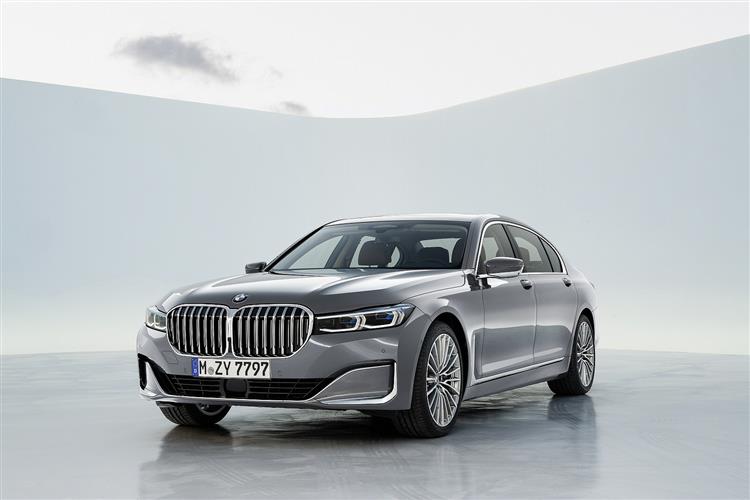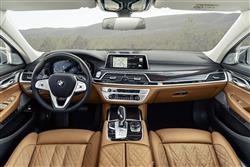A HIGHER 7TH HEAVEN? (some text hidden) SECTIONED_new_bmw7series_2019
By Jonathan Crouch
Introductionword count: 84
When BMW first launched the sixth generation 'G11' version of its top saloon, the 7 Series, it elevated itself back into contention at the top end of the boardroom-level luxury sedan segment. But by 2019, that sector had moved on, hence the need for this significantly revised model. Yes, it makes more of a frontal statement, but equally important were the changes made to the engineering and technology of this car. It was a rejuvenated proposition. Let's check it out as a used buy.
Modelsword count: 3
4dr Saloon (730d/740d/740i/745e/750i/M760Li)
Historyword count: 379
By 2019, the BMW 7 Series had been in production for almost half a century and it had always been a showcase for the Munich maker's latest technology. What it had never really had though was what a large luxury saloon like this really needs: presence. But that changed with this 'LCI' ('Life Cycle Impulse')-series facelifted version of the 'G11'-series sixth generation model. By the end of this century's second decade, the 7 Series had long provided the basic engineering for Rolls Royce models; as part of this update, it got a towering Rolls Royce-style front grille too. Of course, the changes made to this MK6 model weren't only about pavement presence. There was an even more opulent cabin with BMW's latest 'Live Cockpit Professional' screens. And there were new powerplants too; by 2019, BMW had at last found a way of mating Plug-in hybrid technology with an engine six cylinders in size, creating a 745e variant that could stretch up to 36 miles from its larger-capacity lithium-ion battery. The considerably more powerful 4.4-litre twin turbo petrol V8 that the Munich maker had developed for the M5 and the 8 Series models in this period also here found its way into the 7 Series, creating a 750i variant that was virtually as fast as the V12 M760Li flagship version. All models featured improved refinement and, as you might expect, even further enhanced infotainment and safety technology. All of which was important because the fundamentals here weren't changed much from the original version of the 'G11'-series model first launched back in 2015. Perhaps understandably, because that was a very complete car, with futuristic carbonfibre construction and an adaptive fully air-sprung chassis designed to mould itself to the road. This was the first 7 Series model in decades to properly prioritise handling dynamics and the result was a small but significant advantage in driver feedback over its arch-rivals, the Mercedes S-Class and the Audi A8. In short, this car was already very good; it just needed a little more aesthetic confidence. With that in place in this refreshed model, there were more reasons for a captain of industry to covet one. The 'G11' 7 Series sold in this form until late 2022, after which an all-new seventh generation model replaced it.
What You Getword count: 675
According to BMW, by 2019, 7 Series buyers wanted more novelty, differentiation from 3 and 5 Series models and a proper sense of presence. Perhaps even something of a Rolls Royce vibe. Well they certainly got that here, courtesy of the same huge, stately front grille you'll find on an X7. Apparently, Asian and American buyers loved it and for the Munich maker, that was all that really mattered. This frontal appendage is half as big again as the previous grille and pushed up the bonnet and wing line by 50mm, though rather curiously, apparently not to the detriment of aerodynamics, which were actually claimed to be slightly sleeker. The other key front end changes included slimmer Icon Adaptive LED headlights, which from new were optionally available in piercing 'Laserlight' guise, in which form their high beam range is doubled. And inside? Well as is appropriate in a boardroom-level luxury saloon, you get a fabulously opulent cabin, embellished in this revised model with extra matt chrome and piano black finishing for much of the switchgear. As before, there's still perhaps more of a similarity to lesser BMW models than some well-heeled owners might want, but it's hard to fault the cabin ergonomics, which see you perfectly positioned on brilliantly supportive multifunctional 'Comfort' seats trimmed in stitched Nappa leather. And viewing digital screen technology delivered by the standard 'Live Cockpit Professional' package that combines a 12.3-inch digital instrument cluster display with a 10.25-inch centre-dash infotainment monitor, all of it accessible via touchscreen, the usual lower iDrive touch controller or voice control. There's some clever stuff incorporated into this sophisticated set-up, including gesture control and what BMW calls an 'Intelligent Personal Assistant', which works a bit like the 'Siri' or 'Google Assistant' systems you might use on your 'phone and is there to answer questions you can voice to the car as you drive it. Even if you opt for the short wheelbase model rather than the long wheelbase version, standards of rear legroom are still generous, almost exactly matching those of the class standard-setting Mercedes S-Class model of this period, plus you'll enjoy around 30mm more headroom than the equivalent version of that car can offer before reclining your neck into the lovely stitched headrests. A classy touch is provided by smart upper trimming for the front seat backs. Ordinary models came with a conventional rear bench, a seat very much tailored for two; a third adult will sit somewhat uncomfortably on the raised centre section. A popular option was BMW's 'Rear-seat Entertainment Experience' system, which included a Blu-ray player and gives you a couple of 10.2-inch HD touchscreens, which have touchscreen functionality and allow rear passengers to access the entertainment, navigation and online functions of the vehicle. These are controlled via a 'BMW Touch Command' tablet integrated into the central armrest, a removable 7-inch 'iPad'-style screen which can be used anywhere in the car - or even outside of it. This also can operate things like seat adjustment, interior lighting and climate control. There was also an optional 'Executive Lounge rear console'. And an optional 'Executive Lounge Seating' package. With this, you'll be able to recline the rear backrest right back to 42.5-degrees, slide the front passenger seat and backrest right forward out of your way and activate an electrically-operated rear fold-out footrest. Plus the package automatically adjusts the rear seat entertainment screens to suit the angle of your seat. On to luggage space. The boot lid's electrically activated of course; thanks to the standard 'Comfort Access' package, you can raise it with a swipe of your foor below the bumper if, key-in-pocket, you're approaching this BMW heavily laden down with bags. It rises to reveal a 515-litre boot. It's a pity that there was no option to extend the trunk space on offer with retractable seatbacks: after all, even 7 Series owners visit IKEA sometimes. All that was offered was a optional 'Through-loading' ski-hatch. Bear in mind too that if you opt for the 745e PHEV hybrid model, bootspace will fall to just 420-litres.
To see the full road test text contact us on 0330 0020 227
Pictures (high res disabled)

.jpg)
|
.jpg)
|
.jpg)
| |||
.jpg)
|
.jpg)
|
.jpg)
| |||
.jpg)
|
.jpg)
|
.jpg)
| |||

|
Scoring (subset of scores)
Category: Luxury Saloons and Estates
| Performance | |
| Handling | |
| Comfort | |
| Space | |
| Styling, Build, Value, Equipment, Depreciation, Handling, Insurance and Total scores are available with our full data feed. | |



